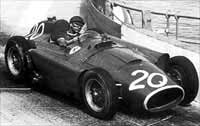Lancia D50

Active: 1954 - 1955
Team: Scuderia Lancia
Specifications
Car: Lancia D50
Constructor: Lancia Italy
Year: 1954 - 1955
Class: Formula 1
Engine: 90 degrees V8
Bore X Stroke: 73,6 x 73,1 mm
Capacity: 2,488 cc
Power: 250 Bhp at 8,100 rpm
Vincenzo Lancia started as an apprentice for Giovanni Ceirano's motor works in Turin that was soon acquired by FIAT, Soon Lancia was driving racing cars along side of their chief driver, Nazarro. In 1906 Lancia started his own firm Automobili Lancia but ironically chose not to compete in racing. Lancia's son Gianni who became managing director of the firm after World War II had inherited his father's love for racing but not his reluctance to involving the family firm. Soon they were racing modified versions of their great Aurielia sports car, considered by some to be the greatest sports car ever built. Gianni's attention turned to Grand Prix racing and plans were made to build a new car de4signed by the famous Italian designer, Vittorio Jano.

The car designed by Jano was quite ambitious in design and in many ways more advanced than the W196 of Mercedes. The four-camshaft V8 was used as a stressed member in conjunction with a tubular space-frame chassis. The engine was offset with the propeller shaft running to the left of the driver. The most visually striking aspect of the car were the twin pannier-type fuel tanks located on faired outriggers between the wheels. Jano's objective was two fold, improved airflow between the wheels and a constant weight distribution as the fuel was consumed during the race. Output for the V8 was a reputed 260 bhp, 3 more than the Mercedes-Benz while the Lancia enjoyed a 280 lb weight advantage.

A vast expenditure for such a small company was lavished on the new racing team as evidenced with the signing of the top Italian driver Alberto Ascari. Initially planned for the 1954 season they did not debut until the last race at the Spanish Grand Prix in Barcelona. In the hands of double World Champion Alberto Ascari the car was fastest in practice. In the race Ascari passed into the lead on lap three setting the fastest lap in the process before retiring due to clutch problems. All seemed set for the next season and the battle with Mercedes.
The opening race of the season in Argentina saw the three Lancias challenge for the lead before retiring with various mechanical problems. Ascari was able to win a couple of minor races, beating the Maseratis and Ferraris at the Turin GP and later the Naples GP. The battle was rejoined with Mercedes at Monaco but Ascari's challenge ended when his car crashed and plunged into the harbour just as he gained the lead. Ascari was rescued only to die four days later in a sports car. Ascari was the star to bring glory to Lancia, his loss devastated the team. This coupled with financial pressures caused the Lancia family to sell controlling interest in the firm and shutter their racing team. Through the intervention of several parties including Fiat the remnants of the team was given to Ferrari. The Scuderia's main contribution to the car was the talents of ex-Mercedes driver Juan-Manuel Fangio. With the withdrawal of Mercedes the path was clear for the Lancia/Ferrari to win the championship. The D50 while going a long way to bolstering Ferrari's flagging efforts was still looked upon as an alien design and Jano's relationship with Ferrari was strained. Further development of many of the key features in the D50 was abandoned and sadly most vestiges of the original car were soon erased.
